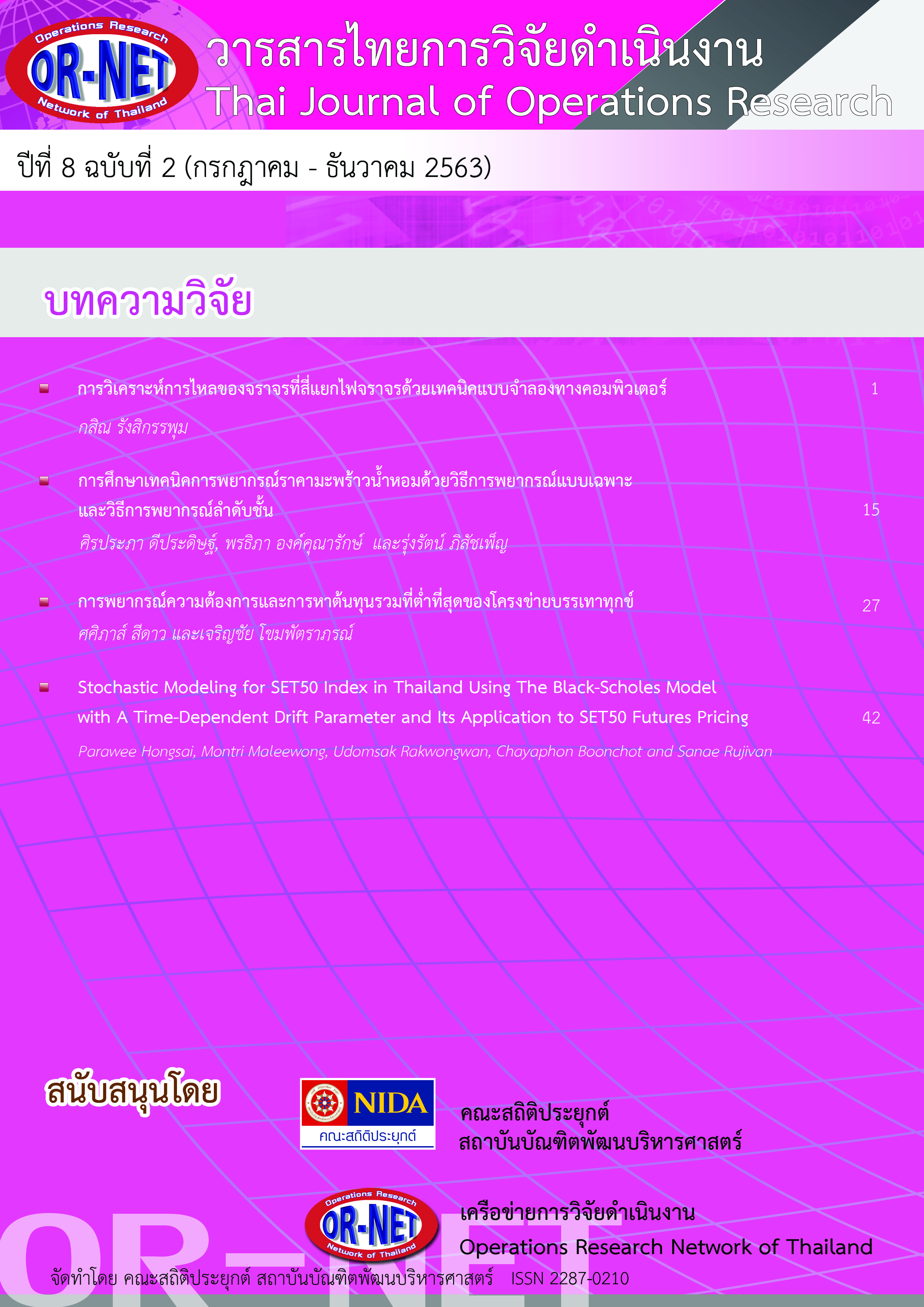Analysis of Traffic Flow at a Red Light Intersection using Computer Simulation technique
Keywords:
Flow analysis, Traffic management, Traffic-light intersection, Ubonratchathani UniversityAbstract
Due to an increasing use of vehicles in major cities in Thailand and around the world, traffic congestion problems are increasing. In particular, traffic at the intersection nearby the urban community and educational institutions is congested by a number of commuters and passengers during the peak time, which causes the problem with flow management. Proper management and analysis of red lights at the intersection also affects the flow of vehicles. In this research, we aim to evaluate traffic problems at the intersection using the agent-based simulation software called AnyLogic. The case study is conducted at the main entrance in front of Ubonratchathani University. Initially, data are collected and then the designed experiments are conducted to test various hypothesized scenarios that affect traffic congestion and to find the best condition for time spent in the system. In particular, two designed experiments are conducted as follows: 1) the experiment to assess the best condition of the traffic light setting, in which the timing of traffic light in each direction is varied for each traffic direction; and 2) the experiment to test how reduced traffic lanes affect the travel time for commuters in the system. The analyzed results show that the best condition for setting up the traffic light is to use 40 seconds for the main roads and 20 seconds for the rest. In addition, reduced traffic lanes in the main roads can affect the time spent in the system up to around 14 %. It is expected that results from this study can be further applied and extended to other situations for effective traffic management.
References
[2] ณัฐกริช เปาอินทร์ (25 กุมภาพันธ์ 2562) ทางออกของปัญหาการจราจรติดขัดในกรุงเทพมหานคร URL: https://www.bangkokbiznews.com/blog/detail/646651
[3] Duranton, G., & Turner, M. A. (2011). The fundamental law of road congestion: Evidence from US cities. American Economic Review, 101(6), 2616-52.
[4] Zhao, L., Lai, Y. C., Park, K., & Ye, N. (2005). Onset of traffic congestion in complex networks. Physical Review E, 71(2), 026125.
[5] Gridlock woes: Traffic congestion by the numbers". Smart Cities Dive. Retrieved 2018-03-28
[6] Mueller, N., Rojas-Rueda, D., Salmon, M., Martinez, D., Ambros, A., Brand, C., ... & Götschi, T. (2018). Health impact assessment of cycling network expansions in European cities. Preventive medicine, 109, 62-70.
[7] Poolsawat, A., Ayutaya, K. S. N., & Pattara-Atikom, W. (2009, October). Impact of intelligent traffic information system on congestion saving in Bangkok. In 2009 9th International Conference on Intelligent Transport Systems Telecommunications,(ITST) (pp. 153-156). IEEE.
[8] Limapornwanitch, K., Montalbo Jr, C. M., Hokao, K., & Fukuda, A. (2005). The implementation of traffic impact assessment in Southeast Asian cities: case studies of Thailand and the Philippines. Journal of the Eastern Asia Society for Transportation Studies, 6, 4208-4223.
[9] AnyLogic (2019) URL: https://www.anylogic.com/
[10] Macal, C., & North, M. (2014, December). Introductory tutorial: Agent-based modeling and simulation. In Proceedings of the Winter Simulation Conference 2014 (pp. 6-20). IEEE.
[11] Good, P., & Perkins, P. (2019). Simulation Software: Anylogic and Vensim.
[12] Pegden, C. D. (2010, December). Advanced tutorial: overview of simulation world views. In Proceedings of the Winter Simulation Conference (pp. 210-215). Winter Simulation Conference.
[13] Ransikarbum, K., Kim, N., Ha, S., Wysk, R. A., & Rothrock, L. (2017). A highway-driving system design viewpoint using an agent-based modeling of an affordance-based finite state automata. IEEE Access, 6, 2193-2205.
[14] Merkuryeva, G., & Bolshakovs, V. (2010, March). Vehicle schedule simulation with AnyLogic. In 2010 12th International Conference on Computer Modelling and Simulation (pp. 169-174). IEEE.
[15] Joo, J., Kim, N., Wysk, R. A., Rothrock, L., Son, Y. J., Oh, Y. G., & Lee, S. (2013). Agent-based simulation of affordance-based human behaviors in emergency evacuation. Simulation Modelling Practice and Theory, 32, 99-115.
[16] Wang, X., Chen, S., Zhou, Y., Peng, H., & Cui, Y. (2013). Simulation on passenger evacuation under fire emergency in Metro station. In 2013 IEEE International Conference on Intelligent Rail Transportation Proceedings (pp. 259-262). IEEE.
[17] Kim, J., Ransikarbum, K., Kim, N., & Paik, E. (2016, May). Agent-based simulation modeling of low fertility trap hypothesis. In Proceedings of the 2016 ACM SIGSIM Conference on Principles of Advanced Discrete Simulation (pp. 83-86). ACM.
[18] Zhao, N., & An, S. (2016). Collaborative management of complex major construction projects: anylogic-based simulation modelling. Discrete Dynamics in Nature and Society, 2016.
[19] นคร ไชยวงศ์ศักดา ประเวช อนันเอื้อ นิเวศ จีนะบุญ และคณะ (2560). การวิเคราะห์คาบเวลาของสัญญาณไฟจราจร โดยการจำลองสถานการณ์ กรณีศึกษามหาวิทยาลัยราชภัฏเชียงราย. Industrial Technology Lampang Rajabhat University Journal ปีที่ 10 ฉบับที่ 1 หน้า 63-74
[20] กสิณ รังสิกรรพุม และวัฒนา (2563) แบบจำลองทางคอมพิวเตอร์แบบตัวแทนสำหรับวิเคราะห์การวางแผนอพยพจากเหตุฉุกเฉินเพลิงไหม้ในกรณีศึกษาอาคารเรียน. วารสารวิทยาศาสตร์และเทคโนโลย ม. ธรรมศาสตร์ ปีที่ 28 ฉบับที่ 10 (ตอบรับ)
[21] Carson, Y., & Maria, A. (1997, December). Simulation optimization: methods and applications. In Proceedings of the 29th conference on Winter simulation (pp. 118-126). IEEE Computer Society.
[22] April, J., Glover, F., Kelly, J. P., & Laguna, M. (2003, December). Practical introduction to simulation optimization. In Proceedings of the 35th conference on Winter simulation: driving innovation (pp. 71-78). Winter Simulation Conference.
[23] Crooks, A. T., & Heppenstall, A. J. (2012). Introduction to agent-based modelling. In Agent-based models of geographical systems (pp. 85-105). Springer, Dordrecht.
[24] Ransikarbum, K. (2009). A procedural validation for Affordance-based Finite State Automata (FSA) in Human-involved Complex Systems. Master Thesis. Penn State University
[25] Ransikarbum, K., Kim, N., Wysk, R. A., & Rothrock, L. (2009). Validation of affordance-based finite state automata modeling. IIE Annual Conference. Proceedings (p. 66). Institute of Industrial and Systems Engineers (IISE).
[26] Law, A. M. (2008, December). How to build valid and credible simulation models. In 2008 Winter Simulation Conference (pp. 39-47). IEEE.
[27] Sargent, R. G., & Balci, O. (2017, December). History of verification and validation of simulation models. In Proceedings of the 2017 Winter Simulation Conference (p. 17). IEEE Press.
[28] Fishman, G. S. (2013). Discrete-event simulation: modeling, programming, and analysis. Springer Science & Business Media.
[29] กสิณ รังสิกรรพุม (2019) เอกสารประกอบการสอนวิชา Six Sigma for Engineering. หน้า 1-136
[30] Kim, H. Y. (2014). Analysis of variance (ANOVA) comparing means of more than two groups. Restorative dentistry & endodontics, 39(1), 74-77.




